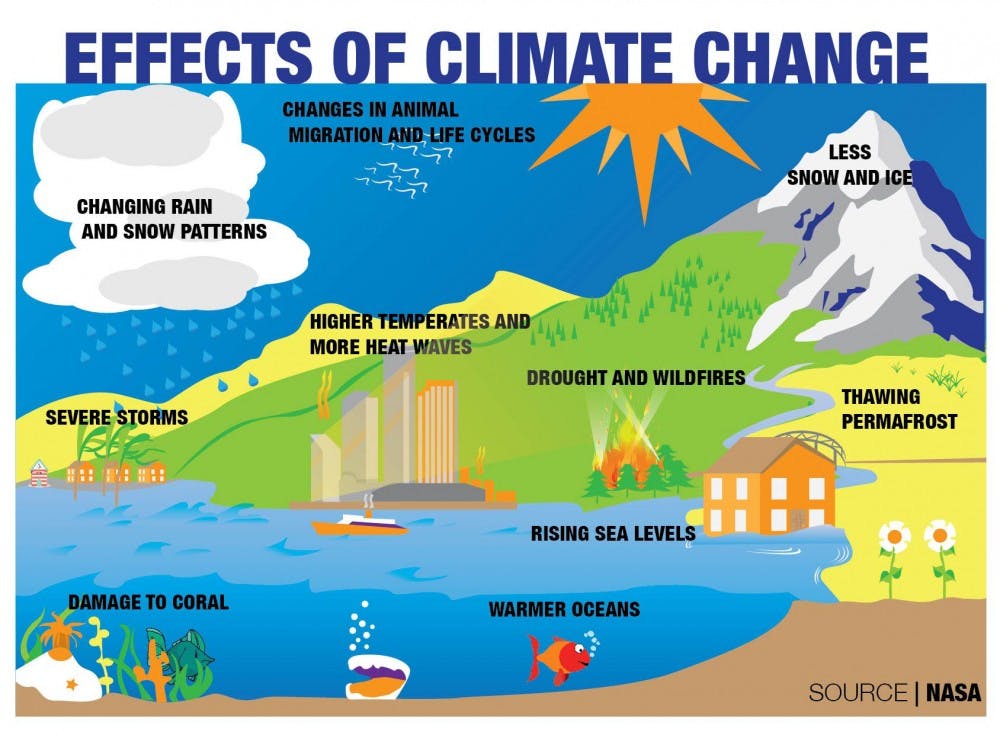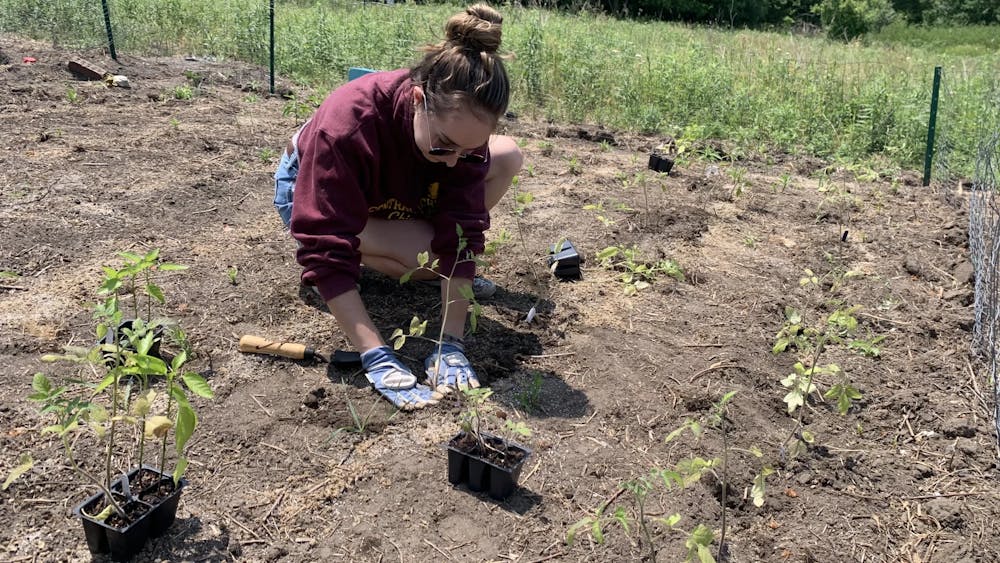Warmer temperatures contribute to billion-dollar weather and climate disasters
Wetter-than-normal conditions in the fall months mean trouble for Mid-Michigan farmers growing standing crops such as soybeans and corn.
Union Township native Randy Recker, who has been farming soybeans, wheat and corn for more than 45 years, said the rain his farm received in October was almost as problematic as the flooding that occurred in June. Over the course of 10 days in October, Isabella County received 11 inches of rain. For Recker that meant having to wait for water to recede before he was able to harvest his soybeans.
“When you get rain in the fall, it's hard for it to go away,” he said. “In the summer, it’ll go away because it's warmer—it evaporates."
A severe storm in June caused an estimated $10-15 million in crop damage for farmers in Isabella County, according to Paul Gross, an educator for the Michigan State University Extension, though a final total isn't expected until January 2018, when crop yields are totaled. Most crops have been harvested as of Nov. 30. The storm is said to be the county’s most costly agricultural disaster.
Carbon dioxide forcing climate change
As of November, 195 countries have signed the Paris Climate Agreement, promising to respond to climate change by regularly reporting its own contribution to reducing greenhouse gas emissions, particularly carbon dioxide. Below are some facts on carbon dioxide's role in climate change.
· Carbon dioxide is an important heat trapping gas which contributes to the Greenhouse Effect.
· Carbon dioxide is released through human activities such as deforestation and burning fossil fuels.
· Carbon dioxide and water vapor influence the balance of net energy at the top of the atmosphere, according to data provided by the National Oceanic and Atmospheric Administration.
· Carbon dioxide is being released at a higher rate than it's being absorbed by major carbon dioxide sinks, such as oceans and plants.
· Human activity, particularly industrialization during the second half of the 19th century are reasons for the historic high carbon dioxide emissions.
· The U.S. ranks first in greenhouse gas emissions and contributions to global warming per capita.
Storms like one experienced by Mount Pleasant residents this summer are occurring more frequently across the nation.
Since 1980, the United States of America has sustained 218 climate and extreme weather events that have caused an overall $1 billion in damage per storm. More than half of those natural disasters occurred in the past decade. Those massive storms resulted in $1.2 trillion in recovery costs. That total doesn't include the estimated $200 billion in damage caused by Hurricanes Harvey, Irma and Maria which have taken place since September.
“It’s been a prolific year for big disasters,” according to Russell Vose, a physical scientist for The National Centers for Environmental Information. Vose said 2017 ties 2011 for the most billion-dollar disasters – 15 – that occurred between January and September.
A draft of the National Climate Change Report, awaiting approval by President Donald Trump, states temperature and precipitation extremes caused by a rise in global average temperatures can affect the likelihood of disasters and extreme weather.
“We can’t say these climate and weather disasters have been caused by climate change,” Vose said. “There have been some studies released in recent years that said ‘these particular events are being influenced by the climate’.”
What does climate change mean?
Confusion about the science of climate change often stems from not understanding the difference between "weather" and "climate."
"Weather is what (conditions are) day-to-day outside," said Daria Kluver, a professor of meteorology. "Climate is the long-term, aggregate statistics of the weather."
Climate is always changing, Kluver explained, but the science surrounding climate change in the national conversation seems to focus on whether humans are contributing to the changes in a significant way.
"Climate can change because of natural reasons — volcanic eruptions cool the climate for a few years (and) the amount of energy the sun puts out, such as solar flares, can change the climate," Kluver said. "(Human) changes are things like emitting greenhouse gases, deforestation and changing the surfaces of the earth so they absorb more or less radiation."
The majority of climate scientists report that human activity significantly contributes to climate change. According to the Climate Change 2014 Synthesis Report Summary, greenhouse gas emissions are at a historical high level and have increased largely as a result of economic development and human population growth.
Greenhouse gases, like carbon dioxide and water vapor, settle in the atmosphere. These gases absorb heat emitted from the Earth's surface. This natural system, the “Greenhouse Effect,” is responsible for keeping the planet warm enough to sustain life.
"Think of the atmosphere as a giant sponge that traps energy in the form of heat, which warms the Earth," Kluver said. “If the atmosphere didn't exist around the Earth, all of that energy would be released into space. None of it would be retained and the planet would be very cold."
The Greenhouse Effect is warming at an alarming rate, Kluver explained. The global temperature is rapidly increasing due to massive amounts carbon dioxide being released into the atmosphere. Human-made industrial processes and burning of fossil fuels accounts for 78 percent of greenhouses gases in atmosphere today, according to the climate change report.
Global temperature data shows that climate change will have drastic effects on the planet’s ecosystems, Kluver said. Ocean levels will continue to rise. Weather will become increasingly erratic if the activity contributing to global warming is not reduced.
"The climate is going to change so much that global populations will have to move if they live by the shore or on islands," she said. "This could potentially result in horrible things (involving) famines, agriculture and immigration due to sea level rising."
Temperatures may increase 4 degrees Fahrenheit by 2100.
"That's really warm," Kluver said. "You're probably thinking four degrees isn't a lot, but we're talking global average temperature."
To put the increase into perspective, Kluver described during the last ice age, 18,000 years ago, the global temperature was only 5-8 degrees lower than the average temperature today.
Melting ice sheets from Greenland and the Antarctic are the biggest contributor to the rising sea-level resulting from record high temperatures melting land ice. Kluver said this will have the greatest impact on humanity.
"People love to live by the sea," she said. "The costal ecosystems, and life that is there, will be impacted. In some cases, salt water from the ocean can be introduced into freshwater systems as a result of severe flooding."
State of the climate
Extreme weather certainly has become a topic of national media coverage. Record hot days are becoming more frequent. Nationally, winters are becoming shorter though sometimes more intense. Wildfire season threatens the western states for longer than ever before. According to data collected by the NCEI the likelihood of drought, flooding and severe storm disasters has increased overall in just the past decade.
Data from NCEI shows that since 1980 more than half of the recorded wildfires, severe storms, and flooding disasters exceeding $1 billion in damage have occurred in the past decade. Scientists don’t have effective forecasting models to prove climate is causing weather disasters. That's because the weather systems form quickly and don't follow a historic trend. What is known, Vose said, is that national and global average temperatures have been breaking historic records.
“Every decade is hotter than the decade is proceeds," Vose said. "It’s been at a steady pace like this for the past five decades."
Humans influencing climate change
Earth’s first breathable atmosphere formed about 500 million years ago. Since then, its climate system has maintained a radiative equilibrium, or balanced the amount of energy coming into and out of the atmosphere.
Radiation entering Earth’s atmosphere travels in the form of short wavelength solar radiation. Only about 46 percent of the energy entering the atmosphere reaches Earth’s surface. The rest is absorbed by clouds, scattered, or reflected back into space.
In order to balance the amount of energy, known as the "net energy at the top of the atmosphere," the radiation leaving the atmosphere must be the same as the amount being emitted to Earth. This balance is currently off.
The net energy of the atmosphere can be thrown off as a result of natural processes like variations in the Earth’s orbit (Milankovitch cycles) and anthropogenic, human caused, climate forcing.
“The natural changes in climate are very slow, occurring over 1,000-year to 10,000-year periods,” said Richard Mower, a meteorology professor. “What we’re seeing now is a very rapid climate change.”
Scientists have run climate models without the influence of human impact, Mower said. Those models have shown that without the influence of carbon dioxide the Earth should be experiencing relatively cool temperatures today. This indicates the change in climate being observed today can’t be contributed to natural processes alone.
According to a temperature analysis conducted by the National Aeronautics and Space Administration (NASA) the average global temperature has increased about 1.4 degrees Fahrenheit since 1880. The rise in global temperatures correlates with an increase of carbon dioxide.
Researchers defend their science
Frustration among young researchers and scientists is growing as some political leaders continue to deny the severity of the effects of climate change.
Dean Horton, a doctorate student studying microbiology at CMU, cited an executive order issued on Jan. 20 banning any federal agencies dealing with research from speaking to the press or releasing their data to the public on platforms such as websites or social media. The ban was lifted nearly two weeks later.
Preventing research from being published, or in any way inhibiting research, harms more than just America. As a leader in scientific research, Horton said if American scientists work is censored, the world of science as a whole is set back.
“If you censor results, or inhibit research from being conducted, it impacts everyone,” Horton said. “In the scientific community, scientists share knowledge with one another regardless if you’re part of a federal agency or academic research.”
Researchers working for federal agencies have always been subject to some degree of censorship. Director of the Institute for Great Lakes Research Donald Uzarski said it is times like this where he feels most for his colleagues who work for the government. Their research funding relies on their cooperation with their administrators, he explained.
“Censorship is not a good thing. It doesn’t belong in science, ever,” Uzarski said. “However, censorship has always been there to some degree. Federal scientists have never had the ability to report on their science as freely as scientists in academia.”
A recent National Public Radio (NRP) analysis of grants awarded by the National Science Foundation found that scientist applying for public grants are "self-censoring" by removing the term "climate change," from their proposals.
The current administration's stance on climate change was made public when the U.S. was pulled from the Paris Climate Accord. The President's 2018 budget proposal, eliminating climate science funding, has left climatologists in a difficult position.
For climatologists, it can be frustrating to have to continuously defend evidence-based science against the opinions aired in the media by people who don’t have backgrounds in that science.
"I think the current administration is ignoring clear evidence of climate change — the impacts it will have on the people living in this country," Kluver said. "They're making decisions they think will benefit them right now. In the long run, they're jeopardizing the safety of the people in this country."




